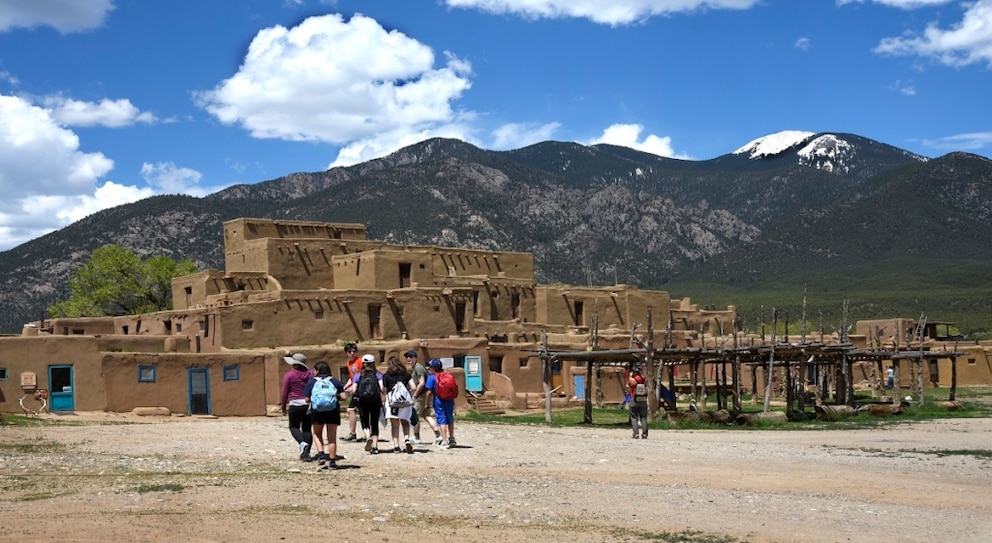May 10, 2025, 9:03 am | Read time: 5 minutes
Taos Pueblo in northeastern New Mexico is considered the oldest continuously inhabited place in the United States. Ancestors of the Indigenous people, who still live here today, have settled in this area for at least 1,000 years. Once a site of thriving trade and bloody conflicts, Taos is now a magnet for artists and tourists from around the world.
At the foot of the Sangre de Cristo Mountains, about 90 kilometers from Santa Fe, lies a very special settlement in the U.S. state of New Mexico. Special in more than one way, Taos Pueblo is likely the oldest continuously inhabited place in the entire United States. Even today, people of primarily indigenous descent live there as their ancestors did, and have lived there for about 1,000 years. The area itself was likely settled much earlier. Taos is also unique because the houses here are almost exclusively made of adobe. Finally, there is a rich history that the old walls can tell.
According to the official website, the oldest buildings still standing in Taos Pueblo were constructed between 1000 and 1450 AD. The original inhabitants of the area simply mixed earth with water and straw to build them. They formed bricks and let them dry in the sun. The finished material was stacked into structures up to five stories high, which are still preserved today and attract visitors from around the world. The unique feature was that to protect against enemies, the adobe houses had no doors. They were entered via the roof using a ladder that could be pulled up in case of danger. The fact that these structures have remained so remarkably well-preserved over the centuries has a special reason.
No Electricity or Running Water

Once a year, an indigenous committee renovates them by applying new adobe to the walls of the houses in Taos Pueblo. Most of the buildings have been in family ownership for centuries, passed down from generation to generation. Indigenous tradition dictates that they still do not have running water or electricity. Therefore, most residents have a more modern house nearby and use their ancient structures mainly for ceremonial purposes. According to the official website, about 150 people still live there permanently, with nearly 2,000 Taos indigenous people living in the area around what is likely the oldest settlement in the U.S.
Today a tourist magnet and a draw for numerous artists, Taos Pueblo was a thriving trade center before the arrival of Europeans, in New Mexico’s case, the Spanish. According to the U.S. National Park Service, the connections of its inhabitants extend across the entire area of the present-day state and beyond. Once a year, after the harvest, there was even a kind of agricultural fair in Taos in the fall, attracting visitors from near and far. Its size impressed even the Spaniards, who began to gradually enter the land from 1540, which the indigenous people had likely inhabited for millennia.
Cruel Punishments
As everywhere, the inhabitants of Taos Pueblo suffered silently for a long time under the yoke of European conquerors. They tried to eradicate their culture and language through bans and draconian punishments. According to “Encyclopedia Britannica,” this led to repeated cruel executions or mutilations. Countless indigenous people were also sold into slavery. Yet none of this could break their resistance against the occupiers, leading to several bloody uprisings. During the 1680 revolt, which went down in history, the people of Taos even managed to free themselves from the Spaniards for 12 years. This uprising cost 400 Spaniards their lives, including many priests who wanted to impose the Catholic faith on the indigenous people.
This drive for independence is likely why many residents of Taos Pueblo today still speak the old tribal language Tiwa, alongside English and Spanish. The town has its own preschool and elementary school, where predominantly indigenous teachers teach. Although the community falls under U.S. jurisdiction, it is officially recognized as an autonomous zone. In 1970, the administration achieved significant success with the return of nearly 20,000 hectares of land. This area includes the sacred “Blue Lake,” an important cultural site. The U.S. government had appropriated the land in 1906. Since 1965, Taos Pueblo has been recognized as a National Historic Landmark. In 1992, UNESCO declared the site a World Heritage Site.

This picturesque castle has a gruesome past

This City Is as Beautiful as Venice but Much Cheaper and Less Crowded

It’s as Beautiful Here as in Tulum — Only Less Crowded
Energy Beings from the Cosmos
According to the “BBC,” many Taos believe that their ancestors once came to Earth from the vastness of the cosmos. They see themselves as energy beings who, after death, return to the sky, from where they originated. Perhaps this spirituality is also a reason why Taos Pueblo attracted artists as early as the 1920s. Patron Mabel Dodge Luhan invited the famous photographer Ansel Adams and painter Georgia O’Keeffe to his estate here. Today, tourists flock to see what is likely the oldest continuously inhabited settlement in the United States.
According to the official website, you have the opportunity to visit daily from 9 a.m. to 4 p.m. However, the village closes to visitors for ten weeks at the end of the year. It is, therefore, advisable to check in advance. Also, be aware of appropriate behavior in Taos Pueblo, as not all areas of the village are accessible to visitors. Several times a year, well-attended indigenous festivities take place here. Even today, for example, the aforementioned agricultural fair occurs in the fall. A regular visit currently costs $25 for adults (22 euros), and admission is free for children under ten.


